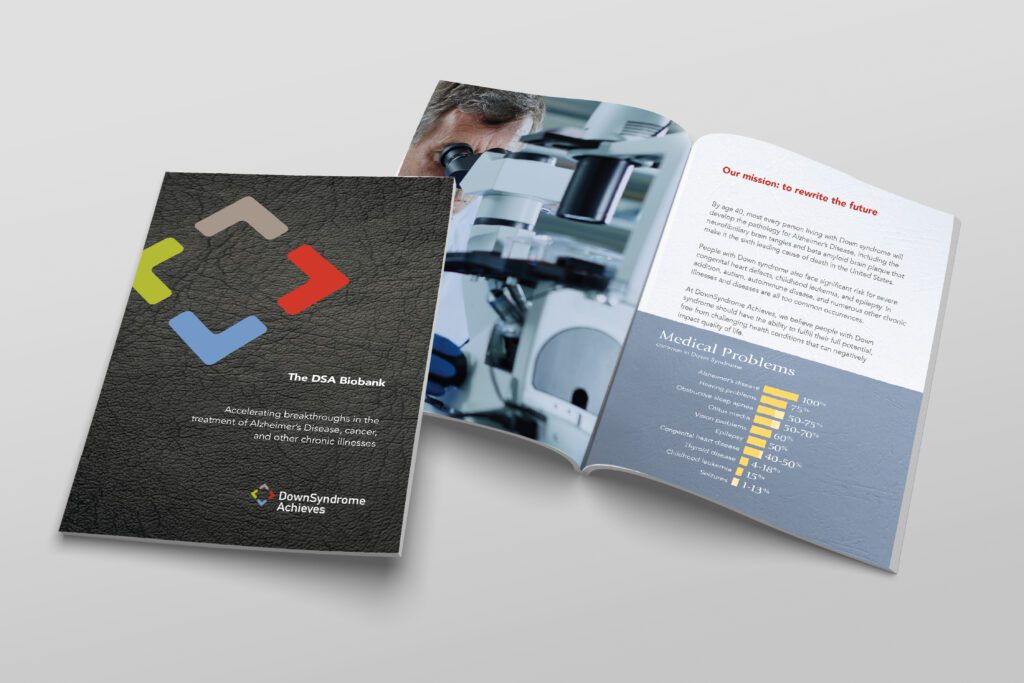Partnering With Researchers
The DSA Biobank: A Researcher’s Valuable Resource
We know researchers use many tools and techniques to find solutions to their questions. One research technique includes studying biosamples. We help researchers discover answers faster by utilizing our DSA Biobank. Our biobank has biosamples collected in advance of a Down syndrome research study. To date, we have completed the Keratoconus Dystrophy study at the University of North Texas Health Science Center.
Soon we anticipate being involved in a microbiome study with the DS Biome (Ireland) and a solid mass tumor study with the European Bioinformatics Institute (United Kingdom). We want to collaborate with you on your Down syndrome study too. Begin by completing our biobank request form.

History of Down Syndrome Research
Down syndrome research has come a long way, but there’s more to discover. The research and medical care timeline from the Global Down Syndrome Foundation, notes the following research milestones:
- 1866– John Langdon Down, an English physician, documented the physical characteristics and intellectual disabilities of those with Down syndrome.
- 1876– An initial association between “premature senility” and Down syndrome was made by researchers. But it wasn’t until 1948 that evidence was published claiming an association between Alzheimer’s and Down syndrome.
- 1959– “Trisomy 21” was a term used in the medical community. Dr. Jerome Lejeune, a French physician, discovered that those with Down syndrome carried three copies of chromosome 21 (and not two).
Lejeune, J., Gauthier, M., and Turpin, R. (1959). Études des chromosomes somatiques de neuf enfants mongoliens. CR Acad Sci (Paris) 248, 1721-1722. - 1960– Researchers discovered a type of Trisomy 21 they termed Translocation, and in 1961 they discovered another type called Mosaicism.
- The late 1970s – Research confirmed the higher IQs of children with Down syndrome who were raised in homes with stimulation vs. being raised in institutions.
- 1983– In the Journal of American Medical Association, research indicated that women age 35 had a 1 in 200 chance of having a baby with a chromosomal abnormality.
- 1990 – The Ts65Dn mouse model was developed by Murial T. Davisson and other researchers at The Jackson Laboratory, replacing the Ts16 mouse model for the majority of Down syndrome research. It continued to live on as one of the best mouse models for research for well over a decade.
Davisson MT, Schmidt C, Akeson EC. 1990. Segmental trisomy of murine chromosome 16: A new model system for studying Down syndrome. In: Molecular Genetics of Chromosome 21 and Down Syndrome, Epstein C, Patterson D (eds), Wiley-Liss, Inc, New York, Progress in Clinical and Biological Research 360:263-280. - The 2000s– Additional research continued, identifying chromosome genes and their association with Down syndrome.
From this scientific research over the last 150+ years, people with Down syndrome have experienced an improved quality and duration of life. We at DSA want to continue the legacy of research for people with Down syndrome.
Funding for Down Syndrome Research
To date, there have not been many researchers interested in conducting studies on health conditions that affect people with Down syndrome. One of the reasons there has been little interest is due to a lack of funding and resources. The path to understanding scientific facts about health conditions that affect people with Down syndrome has been slow because getting access to tools and funding is difficult. A goal of DSA is to reduce the barriers researchers encounter when trying to solve problems. DSA aims to accelerate the pace of research by being advocates, finding funding for research, and gaining access to samples and information to conduct the research.
Additional Resources

There are several organizations that provide funding opportunities for researchers and investigators.
- Include Project (INvestigation of Co-occurring conditions across the Lifespan to Understand Down syndromeE) – Launched in June 2018, this initiative was created to investigate conditions that affect individuals with Down syndrome and the general population, such as Alzheimer’s Disease, autism, cataracts, congenital heart disease, celiac disease, and diabetes. Check out all their new funding opportunities.
- The Alana Down Syndrome Center at MIT offers Technology to Improve Ability grants for graduate and postdoctoral researchers focused on research to improve the quality of life for people with Down syndrome.
DSA Partners Are Advocating for Research
Our partners share our mission to champion Down syndrome research. We collaborate with:
- North Texas Eye Research Institute
- The University of North Texas Health Science Center at Fort Worth
- UCI School of Medicine
- Down Syndrome Biobank Consortium
- DS Biome
- Cincinnati Children’s Hospital Medical Center
- Lee Specialty Clinic
Read more about our partners helping those living with Down syndrome to lead healthier lives
Ethical Considerations With Down Syndrome Research
While conducting all forms of research, it’s important to adhere to ethical norms. This includes upholding the truth while also being true to our moral and social values. Our DSA Biobank does not support, under any circumstance, research seeking to inhibit or prevent the conception or birth of people with Down syndrome. The type of research we promote is to uncover scientific findings that enrich the lives of both those living with Down syndrome and our general population. We are transparent with how our samples are collected and what the rights are of those that participate. We have respect and utmost care for our Down syndrome community, and we look for researchers sharing our same values and ambitions.
Have additional questions?
Visit our researcher FAQ page.